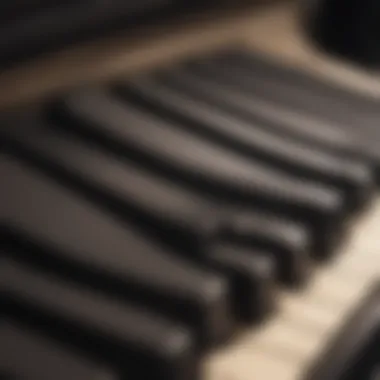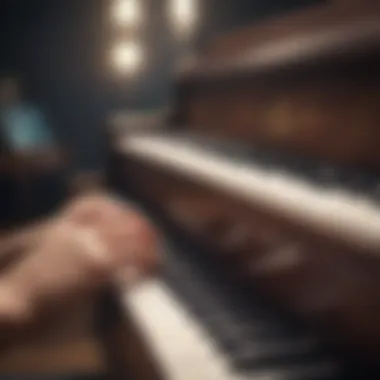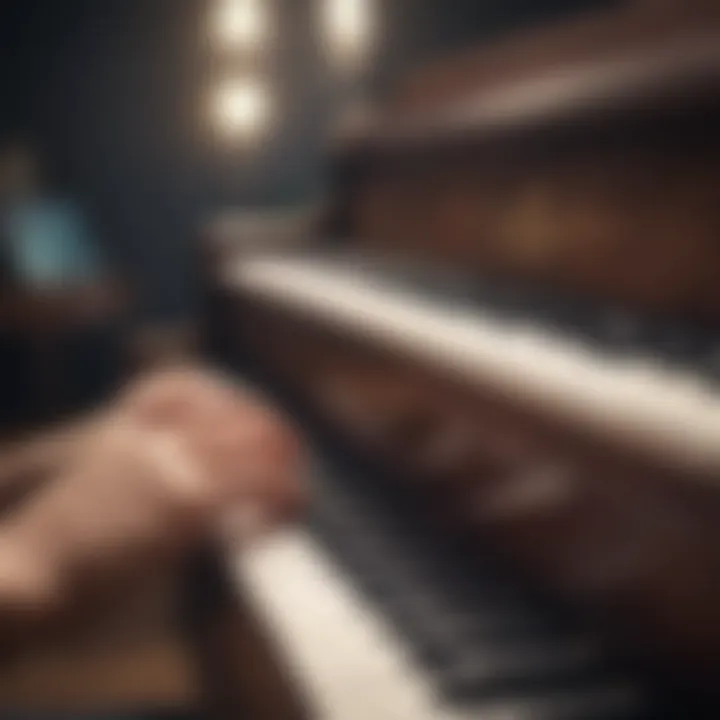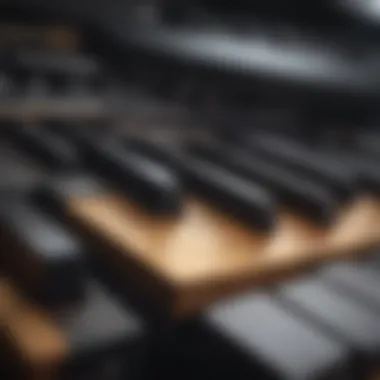Exploring Smooth Piano Chords: A Comprehensive Guide


Intro
Smooth piano chords form an essential part of contemporary music, offering a sense of richness and depth that enhances the listening experience. When musicians explore these chords, they uncover a variety of tonal colors and harmonic possibilities. This guide will shed light on the underlying characteristics of smooth piano chords, their significance in various genres, and practical ways to utilize them in composition and performance.
Understanding smooth piano chords goes beyond mere finger placement on a keyboard. It involves diving into the essential elements that structure these chords, including voicing and progressions. Moreover, their applications stretch across several musical styles, making them relevant for aspiring musicians and established artists alike.
In this guide, we will cover aspects such as chord construction, common progressions, and notable examples from different musical genres. By the end, readers will possess a clearer understanding of how to implement these chords effectively in their own music, grasping their emotional weight and dynamic qualities.
Prolusion to Smooth Piano Chords
Understanding smooth piano chords is essential for any musician aiming to create lush and inviting soundscapes. These chords serve as a foundation for many contemporary music styles, offering rich harmonic textures that can emotionally resonate with listeners. This section will discuss the nuances of smooth piano chords and their significance in the broader context of music.
Defining Smooth Piano Chords
Smooth piano chords are characterized by their pleasant voicings and harmonic progressions. Typically, they include extensions and alterations that add depth to simple triads. A smooth chord often utilizes softer voicings, where the notes are spaced in a way that avoids tension. This can include major seventh chords, minor seventh chords, and added tone chords. The aim is to create a seamless flow between chords, making transitions feel effortless. For example, a C major seventh chord consists of the notes C, E, G, and B. The inclusion of the B adds richness and a gentle dissonance that resolves smoothly to adjacent chords.
Importance of Smooth Harmony in Music
The role of smooth harmony in music cannot be overstated. It enhances the emotional depth of a composition and engages listeners in a way that raw, dissonant chords may not achieve. Questions around what defines 'smoothness' relate closely to the use of particular intervals and the way chords are voiced.
Some key aspects include:
- Tonal Color: Smooth chords contribute specific tonal colors that shape the overall aural experience. Their warm tones can evoke emotions like nostalgia or tranquility.
- Progression Flow: A coherent progression using smooth chords allows the music to unfold pleasantly. Listeners are more likely to stay engaged when the harmonic changes are gentle and predictable.
- Genre Versatility: Smooth piano chords are utilized across various genres including jazz, R&B, and ambient music. Their adaptability makes them valuable tools for composers and performers alike.
Smooth piano chords transform musical landscapes, adding layers of emotion and depth that resonate with audiences.
In summary, the study of smooth piano chords transcends mere technical understanding. It invites exploration into emotion and expression in music, fostering creativity and innovation in compositions and performances.
Theoretical Foundations of Piano Chords
Understanding the theoretical foundations of piano chords is crucial for anyone seeking to enhance their musical skills. Piano chords serve as the building blocks of harmony, and comprehending their structure allows musicians to create richer, more complex musical ideas. In this section of the guide, we will explore essential concepts such as basic chords, chord inversions, and voicings. Each aspect contributes to a deeper understanding of how chord progressions function and what effects they bring to different musical styles.
Understanding Basic Chords
Basic chords, typically consisting of three or more notes, form the core of any musical composition. The most common types of basic chords are major and minor chords.
- Major chords create a sound that is generally perceived as bright and happy.
- Minor chords tend to evoke a more somber or melancholic feel.
A major chord can be built by stacking two whole tones and then a semitone. Conversely, a minor chord is created by stacking a whole tone, followed by a semitone, and then another whole tone. This fundamental knowledge of basic chords sets the stage for more advanced harmonic concepts.
Chord Inversions Explained
Chord inversions change the order of the notes in a chord, which alters its sound and function within a progression.
- Root position: The root note of the chord is the lowest.
- First inversion: The third of the chord is the lowest note.
- Second inversion: The fifth is the lowest note.
Utilizing different inversions can provide variety and smooth transitions between chords. For example, playing a chord in its first inversion can create a smoother bass line and minimize the distance between shifts. This is especially useful when composing or arranging different sections of a piece. Chord inversions allow for creative expression while maintaining harmonic integrity.


Voicings: Wide vs. Closed
Voicings refer to how the notes of a chord are arranged. They can be categorized into two primary types: wide and closed voicings.
- Closed voicings: All the notes of the chord are as close together as possible.
- Wide voicings: Notes are spaced farther apart, allowing for more voice leading options.
Closed voicings offer a compact sound, which can be advantageous in genres like pop and rock. Conversely, wide voicings create a more expansive sonic palette, often employed in jazz and classical styles. The choice of voicing reflects the emotional content of the music and impacts how listeners perceive harmony.
"Understanding and applying chord theory allows musicians to transcend routine playing, giving them the tools to communicate more deeply through music."
Common Chord Progressions for Smooth Sounds
Chord progressions form the backbone of many musical genres. They determine how a piece flows, creating a framework that musicians build upon. In the realm of smooth piano chords, these progressions are essential. They can evoke a wide range of emotions and set the mood of a particular piece. Understanding common chord progressions allows musicians to create smoother transitions in their playing, enhancing the overall harmonic experience.
One of the primary benefits of studying these progressions is that they provide a predictable structure. This predictability helps both performers and listeners connect with the music on a deeper level. Moreover, they act as a foundation that allows for improvisation and creativity while keeping the harmony grounded. Considering the context of the music is also crucial; different genres may prefer certain progressions, making it wise to tailor selections based on stylistic choices.
The I-IV-V Theory
The I-IV-V theory is one of the most fundamental chord progressions in Western music. This progression primarily involves three chords built on the first, fourth, and fifth degrees of the scale. For example, in the key of C major, these chords are C major, F major, and G major, respectively.
This triad is not only easy to play but also versatile. You can find it in various styles such as rock, pop, and country. The strength of the I-IV-V progression lies in its ability to resolve tension effectively. The movement from the I chord to the IV chord creates a sense of anticipation, while transitioning to the V chord amplifies this feeling. Finally, resolving back to the I chord brings closure, making it a highly satisfying experience for both musicians and listeners.
Utilizing the ii-V-I Progression
Another powerful progression for creating smooth sounds is the ii-V-I progression. This structure uses the second, fifth, and first chords of the scale. In C major, the chords are D minor, G major, and C major.
The ii-V-I progression is widely utilized in jazz and many other genres, primarily due to its rich harmonic texture. It introduces a subtle tension with the ii chord, leading smoothly into the dominant V chord before resolving to the tonic I chord. This progression invites improvisation and offers a sense of fluidity. Because of its effectiveness, it is considered essential for any musician's harmonic toolkit.
The Role of the Circle of Fifths
The Circle of Fifths is a fundamental concept in music theory that illustrates the relationships between different keys. Understanding this circle can enhance one’s ability to navigate chord progressions more fluidly. It shows how each key is connected, helping in identifying which chords complement each other effectively.
Using the Circle of Fifths, musicians can explore chord progressions that span across different keys. This flexibility allows for richer compositions and smoother harmonic transitions. For instance, when moving through the circle, the progression often flows seamlessly from one chord to another. This technique is especially effective when crafting bridges or transitions within a piece.
Understanding common chord progressions is essential for creating smoother music and enhances the listener's experience.
To sum up, common chord progressions like the I-IV-V and ii-V-I theory, paired with the insights from the Circle of Fifths, provide invaluable tools for any musician. They heighten the melodic and harmonic depth of compositions, creating an engaging and enriching experience for both performers and audiences.
Exploring Extended Chords
Extended chords play a crucial role in creating smoothness and richness in music. These chords go beyond the basic triads, adding layers of complexity that enhance tonal variety. Understanding extended chords allows musicians to introduce intricate harmonies and emotional depth into their compositions. This knowledge is particularly beneficial for genres such as jazz, R&B, and ambient music, where subtlety is key.
When experimenting with extended chords, musicians should consider their placement within progressions. Using these chords strategically can shape the overall feel of a piece. The smooth transitions that extended chords facilitate contribute significantly to the atmospheric quality of music.
Jazz Chords: Major 7th and Minor 7th
Jazz chords, especially major 7th and minor 7th chords, are fundamental when exploring extended harmony. The major 7th chord consists of the root, major third, perfect fifth, and major seventh. For instance, in C major 7, the notes are C, E, G, and B. This chord has a dreamy sound and is often used to uplift melodies.


On the other hand, minor 7th chords provide a contrasting mood. The formula for a minor 7th chord includes the root, minor third, perfect fifth, and minor seventh. For example, A minor 7 consists of A, C, E, and G. This chord brings a slightly melancholy yet smooth character that complements various styles of music.
Adding Tensions: 9th and 11th Chords
Adding tensions to chords elevates the harmonic experience. The 9th chord introduces a ninth interval to either major or minor configurations, creating a more complex sound. For instance, a C9 chord includes C, E, G, B, and D. Incorporating 9th chords can give a piece more color and unexpected turns.
Similarly, 11th chords also add depth. An 11th chord, such as C11, includes C, E, G, B, D, and F. The presence of the 11th creates a lush ambiance, making music feel fuller and more immersive.
Utilizing extended chords expands your musical vocabulary. Each chord carries its own emotional weight, allowing musicians to express a wide range of feelings through their work.
Practical Applications of Smooth Piano Chords
Understanding the practical applications of smooth piano chords is essential for any musician seeking to enrich their musical palette. These chords serve as the foundation for various genres and can dramatically influence a piece's emotional and sonic depth. Smooth piano chords can create a lush background for soloists, set the mood for a composition, or offer a rich harmonic support that enhances the overall texture of the music.
Whether you are performing, composing, or simply experimenting, knowing how to apply smooth piano chords effectively can elevate your musical expressions. This section will explore the application of smooth chords in three distinct areas: smooth jazz, R&B and soul, and film scoring.
Smooth Jazz: Building a Sound
Smooth jazz is known for its laid-back characteristics, and smooth piano chords are vital in establishing this genre's sound. These chords often feature extended tones with added tensions, such as 7ths, 9ths, and 11ths. They create a scenario where the harmony gently supports the melody without overpowering it.
In smooth jazz, using inversions can help create smoother transitions between chords, maintaining the flow within a progression. For instance, cycling through major 7th and minor 7th chords can provide a warm, inviting atmosphere, ideal for improvised solos. Artists often take these foundational chords and mix them with sophisticated rhythmic patterns to enhance the overall groove.
R&B and Soul Influences
R&B and soul music heavily rely on emotional expression, and smooth piano chords significantly contribute to that feeling. Chords in these genres often incorporate chromatic movements that create tension and release, key elements in songwriting and performance.
The integration of smooth chords in R&B can manifest in various ways, from lush ballads to groovier tracks. For example, the ii-V-I progression used with extended chords, such as Major 9th or Minor 9th, can lead to a rich sound that feels both modern and nostalgic. Furthermore, this genre often emphasizes the importance of the vocal line, with the piano chords supporting and accentuating the melody without drawing too much attention.
Film Scoring and Ambient Music
In film scoring and ambient music, smooth piano chords play a critical role in constructing emotional landscapes. These genres benefit from the ethereal quality of extended chords. The atmosphere that these chords create can guide the audience’s emotional response to visual stimuli, enhancing storytelling.
Composers often use smooth piano chords to evoke feelings of nostalgia, suspense, or tranquility. Chord progressions can be minimalistic, focusing more on textural depth than complex harmonic movement. This allows for a serene backdrop that supports narratives without intrusive elements.
"Smooth piano chords open up a world of musical possibilities, allowing for rich emotional expression across genres."
Engaging with smooth piano chords not only improves technical skills but also enhances overall musical creativity.
Techniques for Mastering Smooth Piano Chords
Mastering smooth piano chords requires deliberate practice and an understanding of various techniques. These methods not only enhance one's skills but also deepen the emotional expression that can be conveyed through music. A solid foundation in playing smooth chords leads to more creative and enjoyable music-making experiences.
Practicing Rhythmic Patterns
Rhythmic patterns are crucial in shaping the sound of smooth piano chords. By varying rhythm, a player can add depth and texture to their music. Here are some effective approaches to practicing rhythmic patterns:
- Explore Different Time Signatures: Experiment with playing chords in 3/4 or 6/8, in addition to the standard 4/4. This can introduce new ways to express ideas and add a unique flavor.
- Use Left-Hand Patterns: The left hand often lays the groundwork for harmonic support. Practice simple bass lines or arpeggiated chords to create a rhythmic anchor.
- Incorporate Syncopation: Syncopated rhythms add complexity and surprise. Offbeat accents can make chord progressions feel more dynamic, enhancing the smoothness of the overall sound.


In practice, one might choose a basic chord progression and play it using different rhythmic styles. This not only promotes flexibility but also helps to internalize rhythms and timings.
Improvisation Strategies
Improvisation offers a way to express oneself and explore possibilities within smooth chords. By developing improvisation skills, musicians can discover new melodies and nuances associated with harmonies. Here are a few strategies:
- Start with Scales: Familiarize yourself with major and minor scales. Use these scales as foundations for soloing over chords. This knowledge helps in constructing phrases that complement the harmony.
- Focus on Motifs: Create simple motifs or phrases that you can vary throughout a piece. This allows for a cohesive structure during improvisation while also maintaining creativity.
- Listen and Imitate: Spend time listening to recordings of skilled pianists who specialize in smooth jazz or similar genres. Imitating their stylings can help you develop a voice.
- Record and Reflect: Recording practice sessions encourages self-evaluation. Listen back to identify areas for improvement and find strengths you can build on.
"Improvisation is not a random act; it’s a conversation between the musician and the music itself."
Through the combination of rhythmic practice and improvisational exploration, an aspiring musician can master the techniques needed to create captivating smooth piano chords. Deeper engagement with these elements will enhance not just the technique but also the emotional resonance of the music.
Resources for Further Learning
Understanding smooth piano chords requires a commitment to continued education. Resources for further learning play a critical role in reinforcing concepts, expanding knowledge, and honing practical skills. With the variety of materials available, from books to online platforms, aspiring musicians can find tailored guidance that meets their unique needs. Such resources not only provide structured insights into piano theory but also deepen one’s appreciation for harmony and soundscapes.
Books on Piano Theory and Harmony
Books remain a foundational resource for learning about piano chords. Texts such as "The Complete Idiot's Guide to Piano Basics" and "Harmony and Voice Leading" are excellent starting points. They cover essential concepts in theory, chord structure, and application in music. A comprehensive guide like "Tonal Harmony" gives an in-depth view of harmony relating to piano music. Each book serves as a reference point, enabling readers to revisit complex topics for better understanding.
> "The more you learn, the better you play. Each book is a stepping stone to mastery."
Online Courses and Tutorials
With the rise of digital learning, online courses and tutorials have transformed how musicians acquire skills. Platforms like Coursera and Udemy offer structured courses focusing on piano chords, theory, and practical applications. Many of these courses include video lessons, assigned exercises, and community engagement, essential for feedback and growth. These resources cater to diverse learning styles, making them accessible to both beginners and advanced players. They also save time and often come at a lower cost compared to traditional learning.
YouTube Channels for Practical Insights
YouTube hosts a wealth of educational content for piano enthusiasts. Channels such as PianoVideoLessons and Josh Wright Piano offer practical insights and tutorials on playing smooth piano chords. These creators break down complex pieces into manageable steps, allowing learners to follow along visually and audibly. This format aids in grasping chords and progressions, reinforcing theoretical knowledge with practical application. Subscribing to such channels can create a routine of learning and practice, making progress enjoyable and engaging.
Utilizing these resources consistently can significantly enhance one’s understanding and execution of smooth piano chords. As learners delve deeper into these materials, they can cultivate their unique musical voices and contribute to the rich landscape of contemporary music.
Closure: The Art of Smooth Piano Chords
Understanding smooth piano chords is fundamental for any musician aiming to enhance their expressive capabilities. This conclusion serves to synthesize the critical elements discussed throughout the article while emphasizing their relevance in various musical contexts. Smooth piano chords, with their unique tonal qualities and fluid progressions, create a gentle ambiance that can transform a piece of music.
A pivotal benefit of mastering smooth piano chords is the versatility it brings to your playing. Smooth chords allow for effective transitions between emotions. By employing various chord progressions and voicings, musicians can effortlessly shift from tension to resolution. Also, applying extended chords introduces richness and depth to compositions, making them feel full and layered.
Consideration of context is essential when applying smooth chords. Each genre possesses its characteristics, and understanding these nuances can elevate your music. Smooth chords in jazz create relaxed yet intricate harmonies, while in ambient music, they evoke a sense of stillness. Recognizing how these chords fit within different styles can broaden your musical palette.
Recapitulating Key Points
To summarize, several key points emerge from our exploration:
- Smooth chords are defined by their fluidity and emotional depth.
- Understanding chord progressions and voicings is crucial for mastery.
- Extended chords enhance tonal complexity, especially in genres such as jazz and ambient music.
- Contextual awareness is vital; smooth chords serve different purposes depending on the musical style.
Encouraging Exploration and Creativity
Encouraging exploration is vital in your musical journey. Take the time to experiment with smooth piano chords in your compositions. Do not limit your creativity to standard progressions. Instead, think outside the box by modifying voicings or incorporating unexpected chord extensions. Music evolves through experimentation, and every modified chord can lead to a new creative pathway.
Resources you can explore include:
- Books on jazz harmony for deeper insight.
- Online courses focusing on piano improvisation techniques.
- YouTube channels that demonstrate real-time applications of smooth chords.
Explore diverse musical genres and listen to how different artists implement smooth chords. The more you immerse yourself in the practice, the more your understanding and creativity will flourish. Embrace the art of piano chords, and allow your musical voice to emerge.







